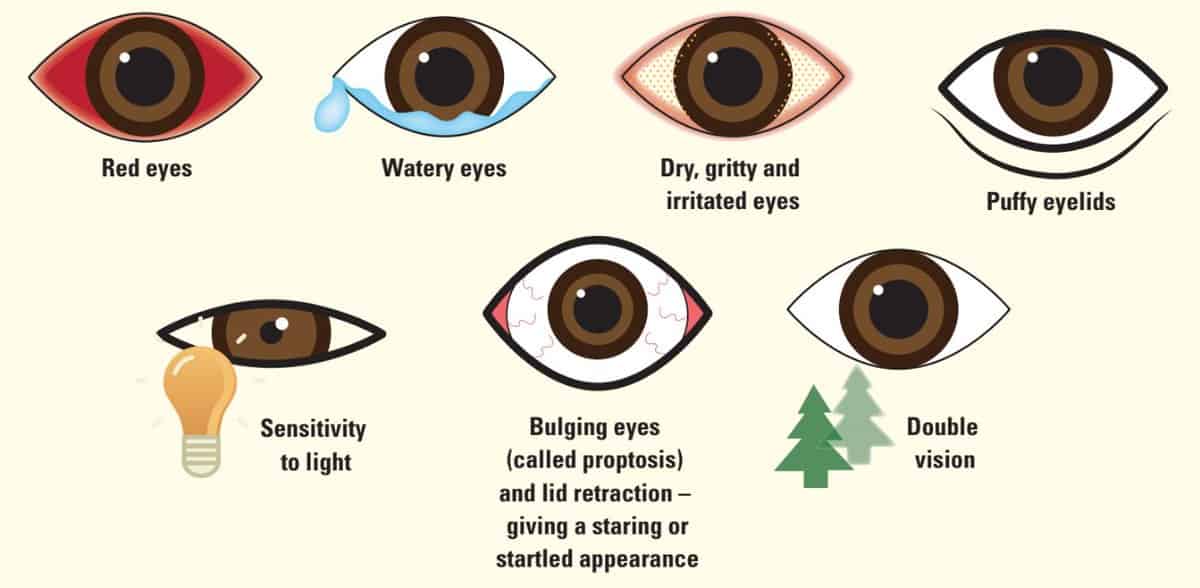The theme of World Thyroid Awareness week 2021 is “It’s not you. It‘s your thyroid”. With this theme, Thyroid Federation International (TFI) – the initiator of Thyroid Awareness Week – wants to raise awareness that thyroid disorders lead to symptoms that are often misinterpreted by those affected.
Did you know thyroid disorders can affect your eyes too? Let us learn a few things about Thyroid eye disease.
WHAT IS THYROID EYE DISEASE?
Thyroid eye disease (TED) is a disease marked by swelling of muscles and fatty tissues surrounding the eyeball within the eye socket.
The swelling of the muscles and soft tissue pushes the eyeball forward, causes double vision, and loss of vision in severe cases due to compression of the nerve connecting the eye to the brain. When the eye is pushed forward, the clear window of the eye (cornea) loses its protection provided by the eyelids and can get damaged.
WHO IS AT RISK FOR THYROID EYE DISEASE?
TED is a rare condition that is seen in women more than men. It usually affects people with an overactive thyroid gland, but can also occur in people with normal thyroid hormone levels or even less. It generally occurs in middle age and is also more likely to develop if you smoke.
WHAT ARE THE SYMPTOMS OF THYROID EYE DISEASE?
Symptoms of TED include:
- Redness and irritation of the eyes as the sensitive cornea is not fully covered or lubricated by the eyelids. In severe cases it can lead to damage of the cornea, causing loss of vision.
- Eye pain.
- Bulgy looking eyes giving a staring appearance.
- Double vision (or diplopia), as the muscles become too swollen to work properly.
- Blurring of vision in advanced cases.
- Difficulty in differentiating colours.
HOW IS THYROID EYE DISEASE DIAGNOSED?
In patients who have already been diagnosed with a thyroid gland problem, TED can be diagnosed during an eye examination. The following tests may also be required:
- Blood tests – to determine the status of the thyroid hormones.
- Scans – A CT /MRI scan of the eye socket (orbit) to determine the status of the eye muscles and the swelling of the eye nerve.
- Other tests – In some cases, a visual field test may be done to determine the extent of compression in the eye nerve caused by the swelling.
WHAT IS THE TREATMENT FOR THYROID EYE DISEASE?
Treatment for TED depends on the stage of the disease.
- Medical – In the early stages of the disease and where the disease stays mild, artificial tears (lubricants) may be sufficient.
- If you have very severe disease, vision is a matter of concern as a result of the disease; you may need steroids (tablets or injections).
- As the disease progresses, you may need immunosuppressive drugs – a family of medicines that dampens down the immune system which is producing abnormal antibodies responsible for TED.
- For Double vision (diplopia), modified glasses or prism glasses can be prescribed.
- Surgical – Immediate surgery may be required in severe cases with compression of the eye nerve.
- Once the eye disease has reached a quiet stage, surgery can be done to make the eyes look normal.
- Orbital decompression is done to make the eyes look less prominent.
IS THERE ANYTHING THE PATIENT CAN DO?
YES. Here are a few tips for patients of TED to help with their condition:
- Stop Smoking.
- Sleeping propped up can help reduce the puffiness around the eyes.
- Wearing sunglasses can help as many patients find bright light uncomfortable.

